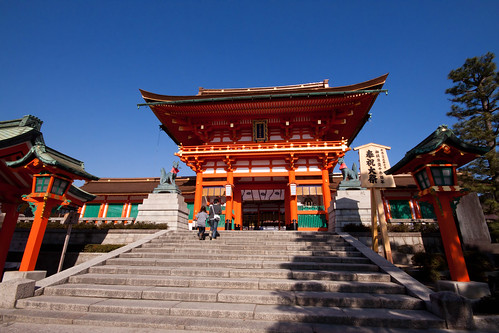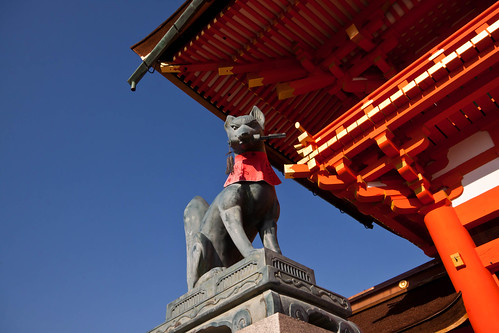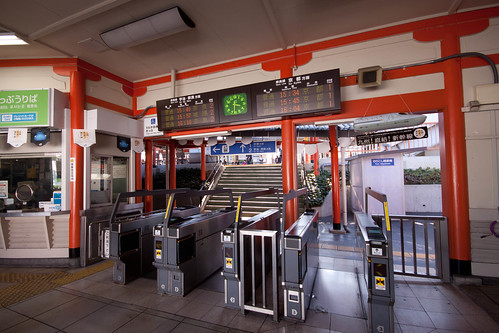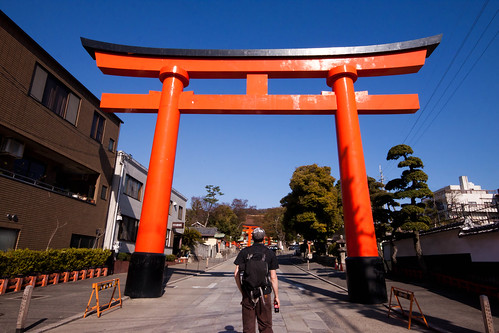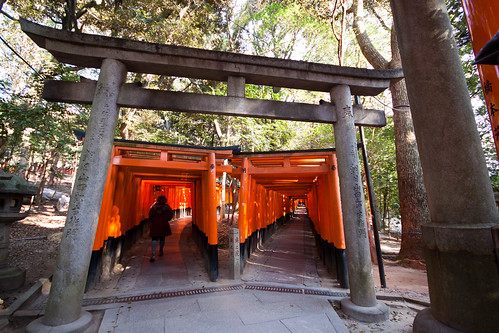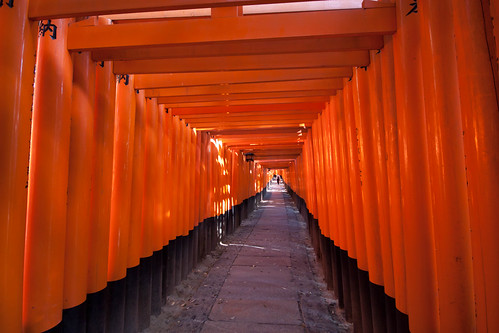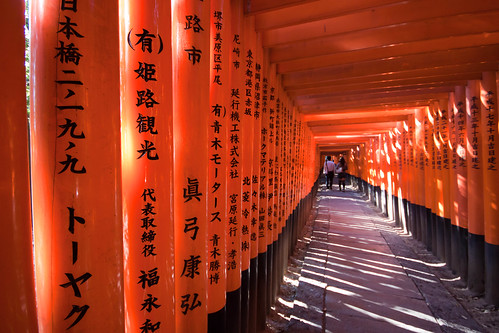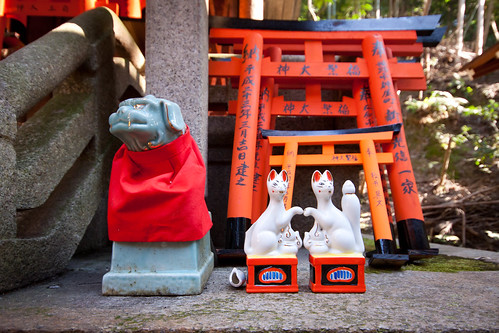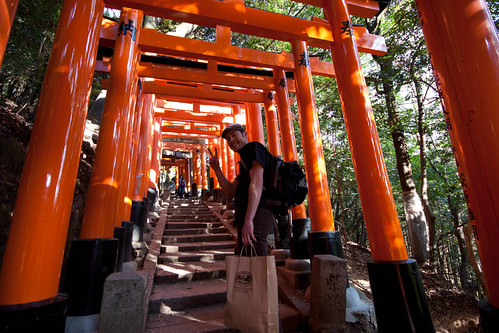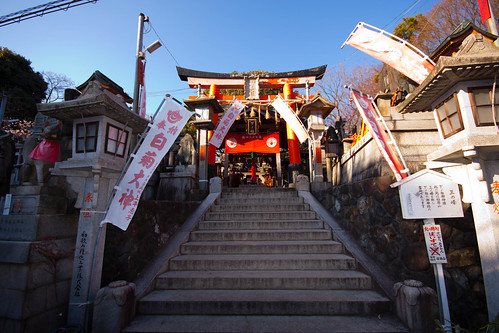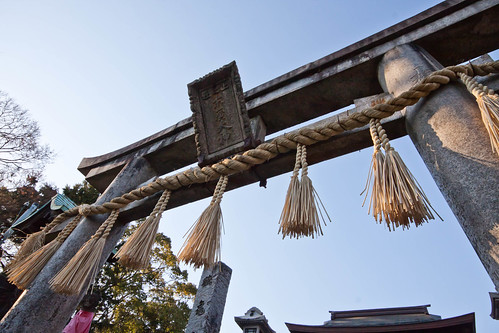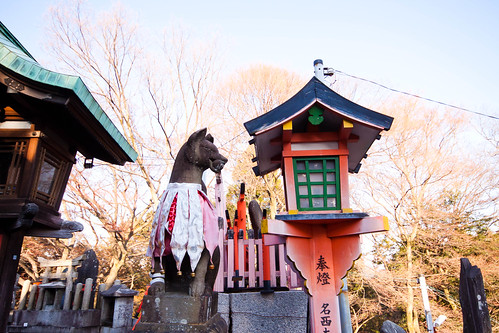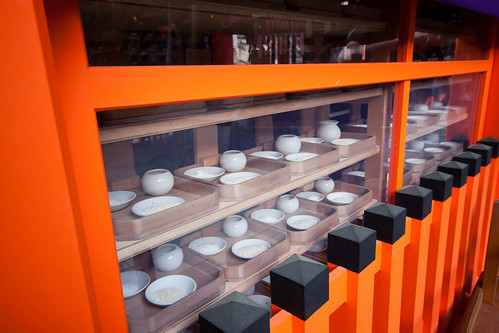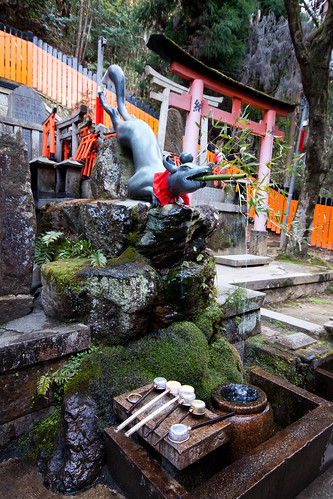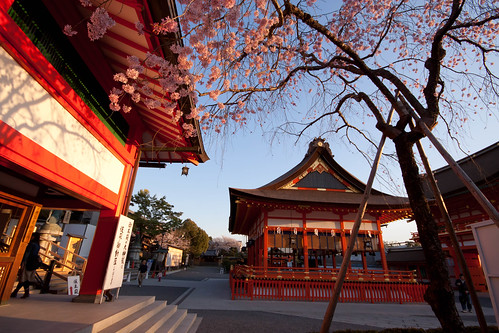Fushimi Inari is the oldest of all Inari shrines in Japan, said to be founded around 711 AD; this date also coincides with the first recorded instance of Inari worship. It’s the head shrine, and the largest, and there are as many as 32,000 other sub-shrines in Japan. Inari is the Japanese Shinto diety (or kami) of agriculture, fertility, rice, wealth, and industry. Her messengers are represented by foxes — kitsune — most commonly found as a duo in front of the shrine – one holding a key to the rice granary and the other holding a jewel or a scroll. The Fushimi complex is also known for the thousands of striking torii gates (“senbon torii”) that line the pathways up to sacred Mount Inari. No one knows exactly how many torii there are, but they are all donated by businesses hoping for wealth and blessings from Inari — the size of the gate coincides with how much the benefactor donates.
Foxes are prominent in Asian folklore – they are known to be wily and cunning, and can often take human form. They can also ward off evil spirits or demons and presumably are enlisted to do this from time to time as they guard the shrine. The red “bibs” these statues wear are called yodare-kake, or suga, and evoke the throat-protector component of traditional Samurai armor. Foxes are Inari’s special representatives; legend tells of a rag-tag group of foxes who visited Inari once upon a time to offer their services and henceforth became the guardians and protectors of the shrines and her messengers or spies.
It’s pretty easy to know that you’re at the right JR station, as it’s decked out in the vibrant burnt-orange colours of the torii gates. The shrine is a very short 3-minute walk from the JR Nara line Inari station, and we visited on the way back from Nara.
As you exit the station, it’s also pretty easy to figure out whether you’re on the right way to the jinja. Just look for the brilliant orange torii gates.
The shrine complex is composed of a 4km walking trail to the top of the mountain and back. We didn’t expect to hike the whole way but we did – it wasn’t too bad, as traversing the shrine-lined pathways you are in essence shielded from the direct sun. And with the light filtering through the orange columns, it makes for a picturesque, atmospheric hike.
On the reverse of each of the gates you’ll see the name of the business that sponsored the gate.
When we reached the Yotsu-Tsuji intersection, we made the decision to continue, taking the path that looked like it careened more steeply to the summit. Yotsu-Tsuji is a halfway point of sorts, offering a glorious view of Kyoto, and the opportunity to take in some refreshments at a couple of small restaurants. Vending machines also begin the line the pathways starting at this point.
Had we been sight-seeing a bit earlier in the day, we might have stopped for a snack at one of these establishments on the way to the summit, perhaps on Kitsune Udon – fried tofu on top of noodles, a fox’s favourite food. Or we might have purchased some sake to consume, or to offer at the shrines. We reached this point near closing-time – 4:30pm.
When we reached this particular shrine at the top of what had seemed to be an interminable series of steps and gates, we thought we had indeed reached the summit. We had not. I was starting to get a little worried — the sun was setting, and we still had the other half of the descent. The top turned out to be another 30 minutes away.
When we did indeed reach the summit, we paid our respects to the shrine there, and began the descent. I was a little weary of taking photos of all the shrines that these two above are the only ones we took at the top. Before we left, we exchanged a few words with the owner of a shop, who was just starting to close down (we had summited a little after 5pm). Basically what we gleaned was that we had indeed taken the path less travelled, literally, as most folks often choose the less steep way. Taking the whole route was definitely worth it (the hike took us around something like 3 hours), but it did feel like we would never finish and get stuck on the mountain in the dark, trying to make our way back through all those Tori gates… as it turns out, the pathways are lit well in the dark, and open year-round, so perhaps another time we’ll choose to make a nighttime journey.
We’re glad we made it all the way around, since we stumbled upon other interesting structures such as this one — what we came to call the rice granary, full of these trays of rice, salt, and perhaps sake. As we were leaving we saw a priest clad in white make his way to the door of the granary with a handful of keys – perhaps a kitsune in disguise?
We also happened upon this beautiful diving fox statue-cum-fountain, and a nearby sign proclaiming something about a “god of sight.” I’m not sure if one corresponded to the other.
Finally – we made it back to where we started, finishing a great day that had started with sightseeing in Nara, and ending after a marvellous hike in Kyoto. More photos on Flickr here.
Note: we visited Fushimi Inari in the afternoon of 6 April 2011. I’m writing these posts after the fact, and out of order; there will be a page listing the posts in proper chronological order in the future.
